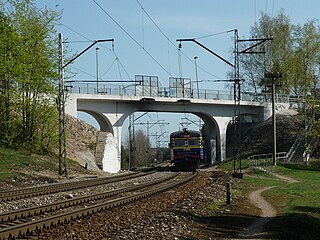Klooga is a small borough in Lääne-Harju Parish in Harju County in northern Estonia. At the 2011 Census, the settlement's population was 1,203, of which the Estonians were 642 (53.4%).

Naissaar is an island in Estonia. It is situated in the Gulf of Finland, northwest of the capital city Tallinn, and is administratively part of the Viimsi parish. The island covers an area of 18.6 square kilometres. It is 8 kilometres long and 3.5 kilometres wide, and lies about 8.5 kilometres from the mainland. The highest point on the island is Kunilamägi, which is 27 metres above sea level. The island consists predominantly of coniferous forest and piles of stones and boulders. In 2020, the island had a population of 17; in 2011 the island had 35 or so permanent residents and some summer residents. Administratively the island is divided into three villages: Lõunaküla (Storbyn), Tagaküla (Bakbyn), and Väikeheinamaa (Lillängin).

The Kopli cemetery was Estonia's largest Lutheran Baltic German cemetery, located in the suburb of Kopli in Tallinn. It contained thousands of graves of prominent citizens of Tallinn and stood from 1774 to shortly after World War II, when it was completely flattened and destroyed by the Soviet occupation authorities governing the country at the time. The former cemetery is now a public park.

The Defence Forces Cemetery of Tallinn, sometimes called the Tallinn Military Cemetery, is one of the three cemeteries of the Tallinn City Centre Cemetery. It is situated about 3 kilometres outside the centre of Tallinn, the capital of Estonia. During Estonian independence before the Soviet and German occupations of the 1940–1991 period, it was Estonia's foremost military cemetery.

Tõnismägi is a 36-metre high hillock adjacent to Toompea hill in Tallinn, Estonia.

Mõigu cemetery was a large Baltic German cemetery, located in the Tallinn suburb of Mõigu in Estonia. It served as the primary burial ground for the usually wealthy and noble citizens of the Toompea parish of Tallinn. Containing numerous graves, it stood for over 170 years from 1774 to shortly after World War II when it was completely flattened and destroyed by the Soviet occupation authorities governing the country at that time.

Mõigu is a subdistrict of the district of Kesklinn in Tallinn, the capital of Estonia. It is located on the northeastern side of Lake Ülemiste. It has a population of 377. Mõigu's former German name until 1918 was Moik, also spelled Moick.
The Kalamaja cemetery, in Tallinn in Estonia was once the city's oldest existing cemetery, located in the suburb of Kalamaja in the north of the city. It contained thousands of graves of ethnic Estonian and Swedish residents of Tallinn and stood for at least 400 years, from the 15th or 16th century to 1964 when it was completely flattened and destroyed by the Soviet occupation authorities governing the country at that time. The former cemetery is now a public park: "Kalamaja kalmistupark".

Kalamaja is a subdistrict of the district of Põhja-Tallinn in Tallinn, the capital of Estonia. It is located just northwest of the historical town centre, on the coast of the Tallinn Bay. Kalamaja has a population of 9,820.

Karjamaa is a subdistrict in the district of Põhja-Tallinn, Tallinn, the capital of Estonia. It's located northwest of Kalamaja and east of Sitsi, main part is between Kopli, Tööstuse and Erika streets. Karjamaa also includes the Hundipea area and the Mine Harbour (Miinisadam) by the Tallinn Bay. Karjamaa has a population of 5,314.

Rahumäe is a subdistrict in the district of Nõmme, Tallinn, the capital of Estonia. It covers an area of 1.75 km2 (0.68 sq mi) and has a population of 3,075, population density is 1,695/km2 (4,391/sq mi).

Liiva is a subdistrict in the district of Nõmme, Tallinn, the capital of Estonia. It covers an area of 3.25 km2 (1.25 sq mi) and has a population of 1,365, population density is 398.8/km2 (1,032.8/sq mi).

Juhkentali is a subdistrict in the district of Kesklinn (Midtown), Tallinn, the capital of Estonia. It has a population of 1,221.

Ott Arder was an Estonian poet, children's writer and translator. He was also the author of several popular songs and written texts.
Meremõisa is a village in Lääne-Harju Parish, Harju County in northern Estonia.

Galärvarvskyrkogården is a cemetery on the island of Djurgården in Stockholm, Sweden. It has about 1,300 burial sites and an area of approximately 0.9 hectares.

Metsakalmistu is a cemetery in the Pirita district of Tallinn.

Alexander Nevsky Cemetery is a cemetery in Juhkentali subdistrict, Tallinn, Estonia; an apostolic part of Siselinna Cemetery. The cemetery is named after the nearby Alexander Nevsky Cathedral.

Pärnamäe Cemetery is a cemetery in Pirita District, Tallinn, Estonia. Its area is 105.6 ha.
Karl Kark was an Estonian civil engineer and politician.
















